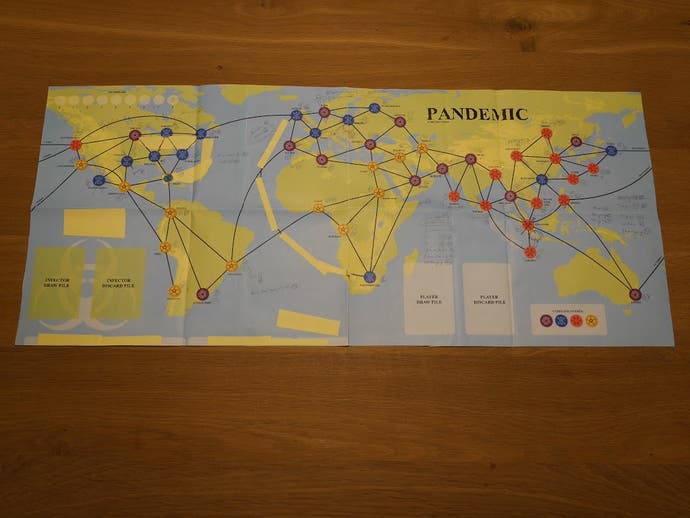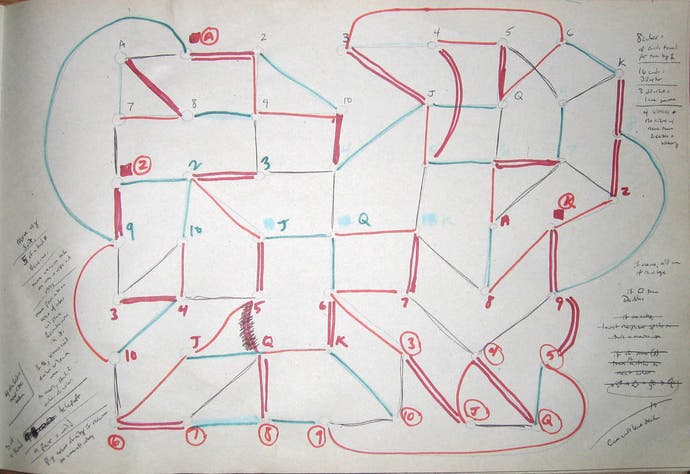The Making of Pandemic - the board game that went viral
Highly contagious.
It's difficult to overstate Pandemic's impact upon board gaming. This game, in which players work together to save the world from an outbreak of deadly diseases, is the most successful cooperative board game of the last ten years, possibly of all time. Released in 2007, its blend of a simple, accessible ruleset framed around a tough, unpredictable puzzle has proved a hit with casual and hobbyist board gamers alike, and proved to both communities that playing together can be just as entertaining as playing competitively.
"I tracked sales of cooperative games before and after the game came out and there was a huge lift in that genre of games that were released as well," says Matt Leacock, the softly-spoken creator of Pandemic, and co-creator of its most recent strain, the mighty Pandemic Legacy. "It was part the reason why I was able to go full-time as a game designer."
The story of Pandemic goes right back to Leacock's childhood, the ideas and experiences that influenced its final form accruing gradually over time. Leacock has been designing games all his life. Growing up in Minnesota, like many of us he used to receive boardgames as a birthday present. But Leacock held boardgames to a slightly higher standard than most children, and was often disappointed with the plastic-heavy, roll-and-move-based products that constituted the bulk of the family gaming market in the eighties. So he'd redesign them into something he did want to play.

"The biggest highlight of my birthday would be getting a game and then it was always followed by a letdown when I tried to play it," Leacock says. " So I would work with my uncle often to turn the game over and work on the back-side to try to design something better with the same components."
Leacock and his uncle's redesigns were remarkably extensive. One project was based off the 1982 game Invader, a tabletop knock-off of Space Invaders for which the only user review on BoardGameGeek comments "They didn't license the game, but it stinks anyways." Leacock and his Uncle flipped the board over, spraypainted it white and drew a grid, transforming it into a space exploration game in which you mined asteroids for resources and sold them at a market. The Connect 4-style chips, which represented the aliens you shot at in Invader, became the resources you traded in Star Miner "We had a little market system and an interesting way to dig down through the asteroids getting more and more valuable minerals as you went," Leacock explains. "I wish I still had a copy of it, it was one of the early ones that we had done together."
Leacock would design games with his uncle two or three times a year, and eventually began working on his own projects. One of these childhood creations was themed around nuclear fission. Players would assume the role of subatomic particles inside a reactor, and attempt to slam those particles against the side of the reactor, with the aim of splitting them to outnumber and eventually overwhelm their opponent. "I loved this idea of things just spiralling and growing out of control," Leacock notes. Twenty years later, this idea would inspire the "outbreak" mechanic of Pandemic, where viruses spread to other cities when the infection in a particular place reaches a critical mass.

For all his experience designing board games, through school, college, and working in graphic design at AOL, Leacock didn't actually try selling a game until the year 2000. when he created Lunatic's Loop, a game about racing east-German Trabants in which the drivers gradually lost their minds as they attempted to destroy their opponents. "I just ran them off my laser-printer. I think I did 200 copies and brought them to Spiel in Germany with a friend. We shared a booth and just tried to sell them by hand."
Leacock managed to sell or give to press every copy he brought, but the trip to Spiel was a sobering introduction to the board game business. "I shipped the pieces to the big conference centre there, and they ask you 'How much do you want to insure it for?' And I was just terrified that something horrible would happen in shipments, I think I insured 'em for the whole retail price and ended up paying more import tax than I made selling the games...it gave me the knowledge that I never wanted to do it again. I really didn't want to publish.'"
On the plus side, while attending Spiel Leacock was invited to Gathering of Friends, a long-running board game event hosted by Alan Moon, the creator of the astonishingly successful Ticket to Ride. Gathering of Friends proved a crucial testing ground for Pandemic, which Leacock brought prototypes of to the event over several years. " I think part of the reason for its success is I played it with just a tremendous amount of people who all gave a lot of really good feedback."
Pandemic's other major outside influence came in the form of Reiner Knizia's Lord of the Rings, a cooperative boardgame version of Tolkien's fantasy epic. "I was really taken with how much drama and how engaging a cooperative game could be," Leacock recalls, "and I wanted to see if I could create, I almost liken it to a cardboard algorithm, a way to generate a feeling of an uncaring enemy, just using paper and cards."

It was this idea, combined with the notion of exponential growth from Leacock's childhood fission game, that formed the central mechanic of Pandemic, a network of diseases that slowly spreads across the game board, broiling in urban centres before blasting out in a half-dozen directions to neighbouring cities.
Leacock began working on the game in 2004, designing it during evenings and weekends away from his job as an user experience designer at Yahoo. He'd playtest the game during lunches, and dream up ideas while taking his baby daughter for walks around the block at weekends. "I remember distinctly coming back from one, just having some seed of an idea. I wanted to use cards that had multiple purposes. So I sketched out a simple network on a scratchpad and grabbed a deck of cards, and just started playing around with the idea.
"And that's when I stumbled into the rule where...when I was trying to figure out the rule with the deck of cards in order to reset the diseases. I had this discard pile, and for some reason I decided to shuffle it and stick that on top of the deck, and realised that would intensify the outbreaks of disease." "Intensify" became the third element of Pandemic's "infection" stage, reducing the randomness of infections and turning already-infected areas into terrible pressure-cookers of disease just waiting to explode.
Pandemic's peculiar theme makes its success particularly fascinating. It seems counterintuitive that anyone would want to play a game about a world slowly turning yellow and black with infection. But such an assumption overlooks the fact that Pandemic is about saving the world from a disease outbreak - and that's a crucial distinction.
"I wasn't interested in creating a simulation, as it were. I was more interested in letting the players feel like heroes," Leacock says. He was very keen that the visual design emphasised this point. "When I got the initial comps of the cover, it was all about panic and there were burning bodies on it, and it's like, there were different ways you could take the game and I really wanted to have a triumphant team," he explains. "It's not really about the ugly side of it. The game could have had a very different shelf presence. God knows what would have happened if it was like that."
Even so, Leacock faced a fair deal of scepticism from publishers when he initially pitched the game. "I heard from a number of publishers that they would never be able to sell a game called Pandemic because the theme was too off-putting. So for a while I actually changed the name to Global Outbreak. When I pitched it to ZMan games though he was like 'Well what do you want to call it?' and I said 'Pandemic' and he was like 'Well we'll call it that then.'"
The first edition of Pandemic released in 2007, and was an immediate hit. ZMan haven't released specific numbers for Pandemic's sales, but Leacock explains that a first-edition game is considered to do well if it sells between 4 and 10 thousand units, and that Pandemic entered a second print run almost immediately. "It was fun to watch on BoardGameGeek because the number of comments just kept growing, and then this is the early days of Internet video, I started seeing people making videos of the game, and it took me aback, because I wasn't expecting that."
Pandemic's success has been bolstered by the release of several expansions, including the splendid "On the Brink", which adds a fifth player who assumes the role of a bio-terrorist and actively works against the other four players. All of Pandemic's expansions were co-designed by Tom Lehmann, a friend of Leacock's who was instrumental in the vanilla game's testing. "I didn't actually design the game to be expanded. I thought it was kind of a fragile system and would be difficult to expand," says Leacock. "Tom has done a bunch of expansions for other designers. It seemed like a really good partnership."

In addition, Pandemic has recently mutated into an even more virulent form, Pandemic Legacy. About three years ago, Pandemic's publisher ZMan were taken over by new owners, and Leacock was brought in to discuss the prospect of doing new games based around Pandemic. "We could do a Pandemic card game, we could do a Pandemic Dice game, we could do Pandemic Legacy. We laughed, hahaha."
Leacock designed the Pandemic dice game, named Pandemic: The Cure, which Leacock says "went really well." But laughing off the notion of Pandemic Legacy hadn't dismissed the idea from Leacock's mind. "So one day I sat down and thought "OK, well what about it?" and started to sketch out some ideas about what Pandemic Legacy might look like. And it wasn't long before I had a couple of big tabloid-size sheets of paper filled with ideas, and I thought 'Oh my God, I've gotta do this'. Within the first hour, I knew I had to do it."
Leacock contacted Zman and asked them to put him in touch with Rob Daviau, the creator of Risk Legacy - a version of Risk that evolves with each game of it you play. The pair enthusiastically agreed that it was a project that wanted to work on, and for the next two years set about designing what is currently the #1 game on BoardGameGeek. "We had no idea it was going to be as popular as it was," Leacock says. "I'll admit I was actually looking at the BGG ratings and graphing a few of them, and I was looking at the trajectory and I was like 'Oh my God.'"
Despite the success of his games, Leacock only became a full-time game designer in 2014 while creating Pandemic Legacy. All the way through designing Pandemic, and for six years after its release, he continued working his day job. Now though, it has finally become more than a hobby. Alongside working with Daviau on Season 2 of Pandemic Legacy, Leacock recently released Knit Wit, a curious little party game that blends wool with wordplay. He's also developing a Chariot-racing game with Pegasus Spiel, and has completed three expansions for Thunderbirds, a cooperative game in a similar vein to Pandemic, only based around goddamned Thunderbirds. All three expansions will be released later this year.
Pandemic's legacy will be an interesting one, in no small part due to the release of Pandemic Legacy. The latter infuses two of the most important boardgaming ideas in recent memory into one revolutionary box, and has captured the imaginations of board gamers in a way that no game has for a long, long time. Pandemic, meanwhile, has dropped down the BoardGameGeek rankings to 50, a fall that is most likely due to the release of its bigger, more ambitious brother.
Yet there remains much to be said for the original game, and its elegant simplicity. It lets you save the world through science rather than swords or spaceships, and that theme is as easy to understand as its beautifully straightforward rules. Ironically, the idea of fighting a global outbreak of horrible diseases is a concept that anyone can comprehend. In his Eurogamer review of Pandemic, Quintin Smith described it as "the perfect game to start your collection." I believe that still holds true today.

